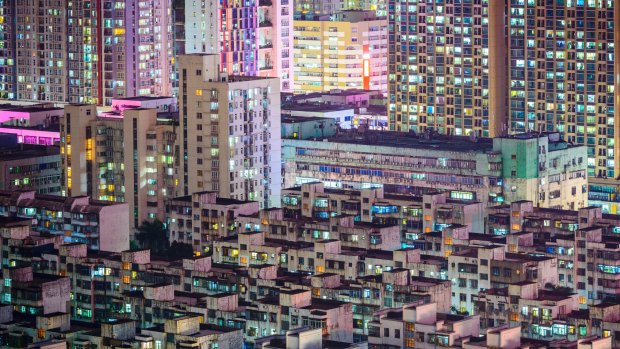By David Whitley
Around the world, there are several tiny places that for one reason or other, most people recognise. Stratford-upon-Avon, Lourdes and Waterloo fall into that category. But what about the flipside – the enormous cities that only the most ardent map geeks can bring to mind? Well, there are plenty of them – giant metropoles of more than two million people that leave the bulk of us thinking: "What? Where?" Such as…
Dongguan
Where? China. Population: 8.2m.

Dongguan, China.
About 55km east of Guangzhou in southern China, Dongguan is effectively a collection of manufacturing towns that would still be regarded as fairly major cities elsewhere. Well, on the clean side of things there is, anyway – Dongguan has a rather seedy rep for sex industries.
For visitors, however, there is one attraction worthy of attention – the Opium War Museum (ypzz.cn/en), which tells of the battles that effectively kicked off the global drugs trade.
Ningbo
Where? China. Population: 7.6m.
Lying south of Hangzhou Bay from Shanghai, Ningbo is a massive port and industrial hub in Eastern China. Around 7.6m people live within the city's admittedly large administrative area, but unlike many of China's obscure megacities, Ningbo has a fairly strong heritage.
Once on the Silk Road trading route, Ningbo's tourist attractions include the Tianyi Pavilion – an ornate library dating back to 1561. There are also the 14th century Tianfeng Pagoda, and several temples.
Wuhan
Where? China. Population: 6.9m.
We could pick out dozens of cities from China here – Foshan, Zunyi, Shantou and Suzhou are amongst the little-known big boys – but Wuhan is the other absolute, sprawling monster. Approximately halfway between Beijing and Guangzhou, and at the intersection of the Yangtze and Han rivers, it's a regular stopping point for river cruises. Highlights include the blossom-surrounded East Lake and the better-than-it-sounds Hubei Provincial Museum, which is packed with hundreds of thousands of artefacts going back through centuries of Chinese history.
Surat
Where? India. Population: 4.5m.
Once a major Indian trading port for the Portuguese then British empires, Surat is a big diamond cutting and textiles hub. There's little for visitors to get excited about beyond a fairly generic aquarium-zoo-science museum combo, a few temples and gardens.
Pune
Where? India. Population: 3.1m.
Overshadowed by nearby Mumbai, Pune was a fairly major colonial army base under British rule. Now, some of the old buildings remain, but they're swarmed out by the signs of India's modern economic boom.
Unusually for this list, the city has a decent tourist pull. The Aga Khan Palace and Raja Dinkar Kelkar Museum – which is an eclectic collection of utterly random stuff collated by one man – are highlights. But the big ticket for those with a spiritual bent is the Osho International Meditation Resort (osho.com), a flashily OTT yoga-factory.
Belo Horizonte
Where? Brazil. Population: 2.5m.
Football fans may recognise Belo Horizonte as the city where Germany thrashed Brazil 7-1 in the 2014 World Cup semi-final. It's a 20th century planned city – Brazil's sixth largest.. A couple of decent museums – one on natural sciences, another on arts and crafts – plus some striking examples of modern architecture are amongst the slim pickings for visitors.
Kano
Where? Nigeria. Population: 3.6m.
Nigeria's second largest city is the major hub of the country's troubled north. To say it's not much of a tourist city would be a dramatic understatement – although the dye pits are worth a look. They're over 500 years old, and it's easy enough to tee up a guide to take you round them.
Ekurhuleni
Where? South Africa. Population: 3.2m.
Few will have heard of Ekurhuleni, but quite a lot will have been there – it's where Johannesburg's Oliver Tambo International Airport is found. It's more of a conurbation than a city, with several rather anonymous towns and township clustered together in the eastern portion of South Africa's Gauteng province.
Despite 3.2m people living there, there's a staggering lack of attractions for visitors. Let's put it this way – we looked at two guide books and found nothing. Even Wikitravel (wikitravel.org), which usually lists any old church or temple, had absolutely nothing in the "Do" section. Still, nice airport – and Charlize Theron was born there.
Mashhad
Where? Iran. Population: 2.7m.
In the north-east of Iran, Mashhad is an important place of pilgrimage for Shiite Muslims – the tomb of Imam Reza pulls in millions every year. Because of this, it is surprisingly well set up for tourism – although there isn't all that much to lure in non-Muslim visitors, besides a string of rather lovely parks and a handy position between two mountain ranges.
Within Iran, Mashhad is renowned as the birthplace of many poets and writers, and the cultural leanings are nodded to with a serious of often-quirky sculptures and statues around the city.
Medan
Where? Indonesia. Population: 2.1m.
Near the northern end of Sumatra, Medan is the largest Indonesian city outside Java. For visitors it tends to be used as a transit hub at best. And that's being charitable.
The nearby Vihara Maha Maitreya temple is supposedly the biggest Buddhist temple in South-East Asia, while there are also a few nice examples of colonial Dutch architecture and a couple of water parks. But otherwise, it's a "challenging", "gritty" city more known for its prodigious levels of caked-in dirt and open sewers.
Sign up for the Traveller newsletter
The latest travel news, tips and inspiration delivered to your inbox. Sign up now.